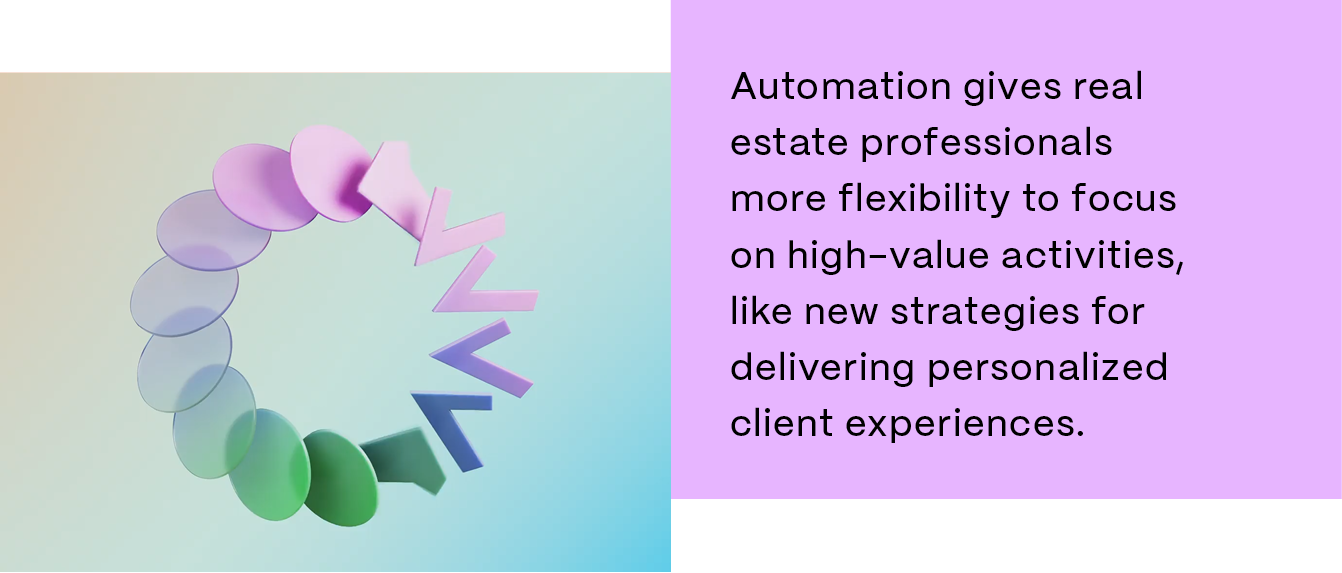
Blog
Transform your real estate business process with strategic workflows

Time management strategies are crucial for real estate professionals. The industry provides more opportunities than most to develop your own schedule and work processes. That’s why the workflows you use every day play a major role in your business’s success.
In this article, we explore what real estate workflows are, why they matter, and how you can make yours more impactful with automation technology. Keep reading for industry-specific insight and advice.
Key Takeaways
- Real estate workflows define the necessary steps for real estate professionals and businesses to complete daily processes effectively.
- Building better workflows leads to significant benefits like time savings, increased productivity, and improved collaboration with clients and internal teams.
- Workflow automation lets you maximize efficiency and reduce human error.
- For more successful workflows you need a flow chart, the right automation tools, and a template library.
What is a real estate workflow?
A real estate workflow defines the necessary steps for real estate professionals and businesses to complete daily processes effectively. At each stage, it outlines what needs to be done, who is involved, and best practices to follow.
Types of real estate workflows
In real estate, there's a range of businesses with different functions. To address that, there are many types of workflows. Here are some examples:
- A commercial real estate firm develops a real estate transaction workflow that outlines actions to finalize a property sale once a buyer is found.
- A property manager follows a set procedure describing how to inform tenants when routine maintenance is scheduled.
- A real estate development firm uses project development workflows to standardize property construction.
- A real estate investment trust establishes consistent processes for staff to assess which properties are the most promising investment opportunities.
Real estate workflow benefits
A standardized, streamlined approach to work can provide many benefits for real estate companies. The most important advantages include:
- Time savings: Clearly establishing best practices helps you follow the most efficient steps to complete tasks.
- Heightened productivity: Optimizing processes allow you to get more done and give your business a competitive edge.
- Enhanced collaboration: Building effective workflows improves client communication in real estate, fostering stronger relationships with customers. These also improve internal communication for better teamwork.
- Confidence and peace of mind: Using consistent procedures, staff always know what to do next. This reduces stress and minimizes errors.
- Additional referrals: Leveraging workflows that lead to higher-quality results for clients will boost satisfaction and make them more likely to refer friends and colleagues to your company.
What role does technology play in optimizing real estate workflows?
As you build out efficient workflows for your business, automation technology will be critical to maximize the benefits described above. These tools handle repetitive tasks to save you time and help reduce human error.
When workflows are streamlined, employees can spend less time on mindless, tedious tasks and more time delighting customers. Automation provides real estate professionals with more flexibility to focus on high-value activities, such as delivering a personalized customer experience and coming up with new initiatives. The real estate industry is highly competitive, but investing in the right technology can help your business stand out.

4 tips for creating powerful real estate workflows
To take the stress out of everyday operations consider using the following four tips for creating workflows.
1. Develop a workflow real estate process flow chart
Always map out your processes to better understand existing workflows and decide where to implement automation. These can be developed on paper or with a digital flow chart tool. Once you can visualize each step, it’s easier to come up with ideas for how to get rid of unnecessary tasks. It can also help you better understand how to use technology to gain key advantages such as reduced friction and improved efficiency.
2. Choose the right automation tools
Conduct thorough research to select workflow automation tools that empower your company to get ahead. As you look for a solution, consider the following questions:
- Does it have all the features you need? To get the most out of your investment, look for technology that assists with multiple business processes and functions.
- Does it integrate with existing systems? Compatible software will let you adopt automation quickly and experience the benefits faster.
- Is it scalable? The best technology will continue delivering value as your company grows. Implementing flexible solutions now will save time and energy later because you won’t have to look for new tools when your automation needs expand.
- Does the vendor have positive reviews? Find out what past customers are saying and be sure to pick vendors that offer reliable, high-quality support.
Related read: best workflow automation for small businesses
3. Create a template library
Avoid unnecessary work by building out templates for every type of document you frequently use. Contracts, leases, and legal agreements have a standard structure businesses can replicate and fill in with specific details on clients and business dealings. A template library ensures outlines of these files are already prepared, saving staff the effort of creating documents from scratch.
To save employees even more time, use automation to pull from databases and fill in necessary information. This way, all they have to do is review final documents.
Related read: Unlock efficiency and streamline workflows with templates
4. Collect feedback and continuously optimize
To uncover necessary process adjustments, gather feedback from clients and staff on how company procedures could be improved.
As technology and your business evolve, you may discover new opportunities to increase efficiency and client satisfaction. Use automation to send out surveys on a regular basis, and assign a team of stakeholders to act on the input you receive.
Streamline workflows to revolutionize your real estate business processes
Strategic workflows can help your real estate business reach its full potential. Simplifying your approach and protocols unlocks greater efficiency, productivity, employee confidence, and collaboration — all of which lead to more word-of-mouth referrals. Automation tools let you maximize these benefits by reducing repetitive work and human error.
It’s time to find out where better processes will take you. Follow the tips outlined in this article to start transforming your real estate workflows today.
Related Resources
